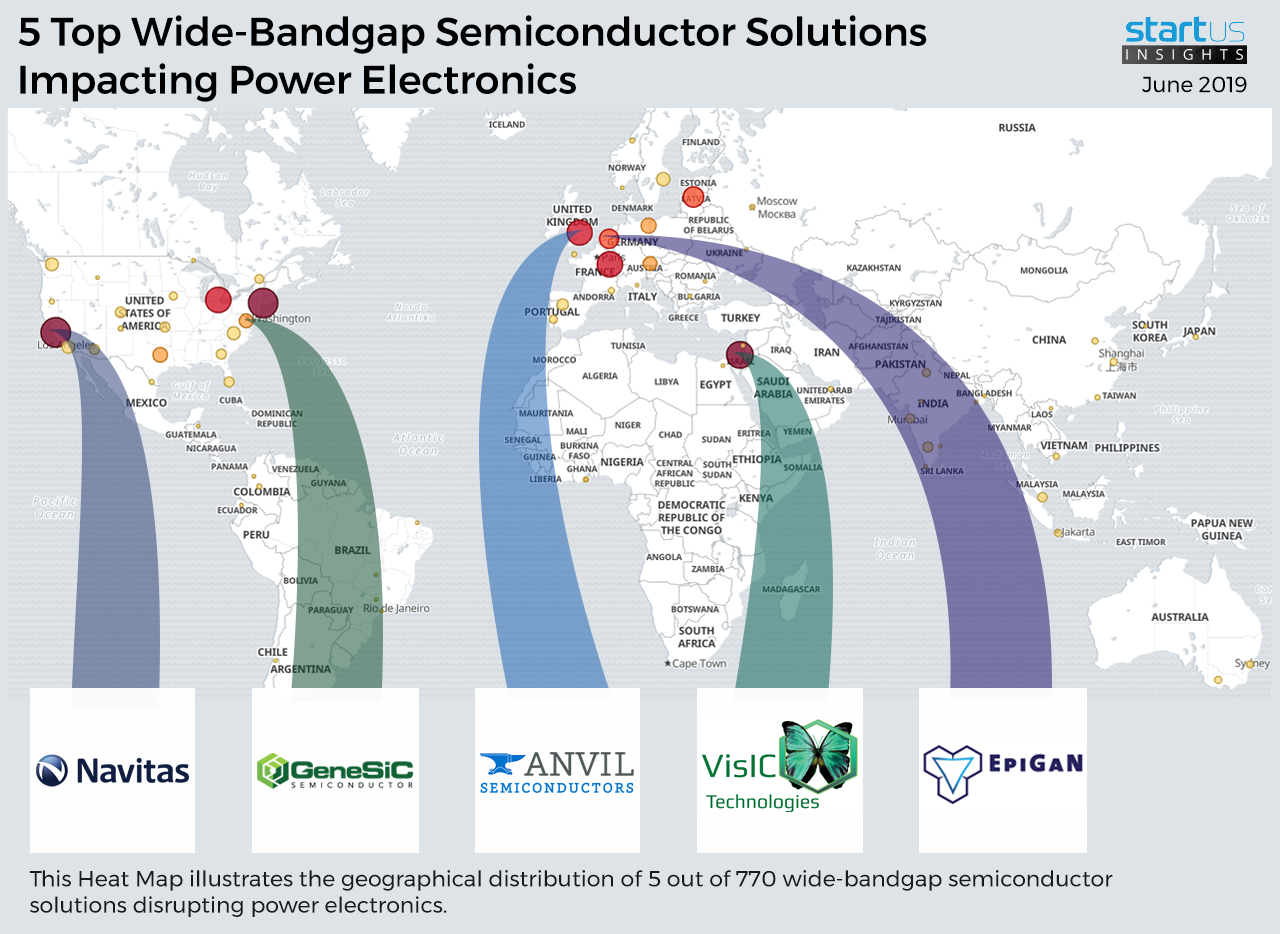Our Innovation Analysts recently looked into emerging technologies and up-and-coming power electronics startups. As there is a large number of startups working on a wide variety of solutions, we decided to share our insights with you. This time, we are taking a look at 5 promising Wide Bandgap (WBG) semiconductor solutions.
Heat Map: 5 Top Wide Bandgap Semiconductor Startups
For our 5 picks of startups, we used a data-driven startup scouting approach to identify the most relevant solutions globally. The Global Startup Heat Map below highlights 5 interesting examples out of 770 relevant solutions. Depending on your specific needs, your top picks might look entirely different.
One of the most famous concepts in innovation is the Innovation S-Curve or the technology life cycle. It helps to identify the technologies that are mature and to spot new technologies that are emerging and might surpass the physical and performance limitations of existing technology.
Looking at similar patterns in the semiconductor sector, Silicon (Si)-based semiconductors are the most commonly used in the market segment of power electronics. However, Si-based semiconductors are reaching their theoretical limits due to the factors such as their inability to provide a differentiated market offering for the end users. They are also reaching their material’s physical limitations, which naturally leads the industry to explore new materials with better performance such as Wide Bandgap Semiconductors.
The major benefits of WBGs are:
- Higher energy efficiency
- Ability to sustain and withstand high temperature
- Higher breakdown voltage
- Smaller size
- Robustness in harsh conditions
Today, the commercial applications WBGs that are commonly used are SiC (Silicon Carbide), GaN (Gallium Nitride) and Diamond. Let’s take a look at the main applications of WBGs are:
Data Center Infrastructure
Around 3% of the world’s electricity is consumed by data centers. Such a power-hungry segment is looking for solutions that bring them efficiency in operations. Deploying GaN-based racks and other SiC devices can save energy at an exponential magnitude. US-based Navitas Semiconductors develops GaN Power IC that finds its application in data centers and other power electronics applications with a potential to increase switching speed by 100x and energy saving by 3x.
Photovoltaic & Wind Energy Inverter
The aim of photovoltaic energy producers is to maximize the efficiency of power generation by deploying WBG-based energy conversion system (inverters), which reduces power losses during power generation and transmission. US-based startup GeneSic Semiconductor supplies multiple SiC devices such as the latest 1700V SiC Schottky rectifier for solar inverter applications.
VisIC Technologies – Industrial Drive Motors
The Variable Frequency Drives (VFD) that encompass a WBG element could allow to dynamically adjust the speed of motors according to the power requirements. This, in turn, brings efficiency and energy saving to drive motors used in different industries. Israeli VisIC Technologies offers 650V GaN Transistors whose efficiency and switching frequency range of VFD and servo motors result in low cost, smaller size, and less power loss.
Anvil Semiconductors – Traction In Rail
The traction system deployed in electric rails converts electrical energy into mechanical energy for rail locomotion. A SiC-based traction drive system is reported to reduce energy consumption by 38.6% compared to a conventional system. UK startup Anvil Semiconductors develops a SiC-based power system that finds its application in multiple domains including traction systems in the rail industry.
EpiGaN – 5G Communication
The use of GaN-based amplifier in 5G carrier aggregation technology for large volume data transfer can provide higher power efficiency. Belgian EpiGaN, a spin-off of Imec, manufactures GaN on Si epiwafer for power switching applications such as RF devices and 5G networks, which enables multiple benefits such as high data transfer and low latency.
What About The Other 765 Solutions?
While we believe data is key to creating insights it can be easy to be overwhelmed by it. Our ambition is to create a comprehensive overview and provide actionable innovation intelligence for your Proof of Concept (PoC), partnership, or investment targets. The 5 startups showcased above are promising examples out of 770 we analyzed for this article. To identify the most relevant solutions based on your specific criteria and collaboration strategy, get in touch.

![Explore the 10 Top Startups to Watch in Stuttgart [2025]](https://www.startus-insights.com/wp-content/uploads/2025/02/SharedImg-StartUs-Insights-noresize-420x236.webp)
![Explore the 10 Top Startups to Watch in Dublin [2025]](https://www.startus-insights.com/wp-content/uploads/2025/02/Dublin-Startups-SharedImg-StartUs-Insights-noresize-420x236.webp)
![Explore the 10 Top Tech Startups to Watch in Hong Kong [2025]](https://www.startus-insights.com/wp-content/uploads/2025/02/Hong-Kong-Tech-Startups-SharedImg-StartUs-Insights-noresize-420x236.webp)




